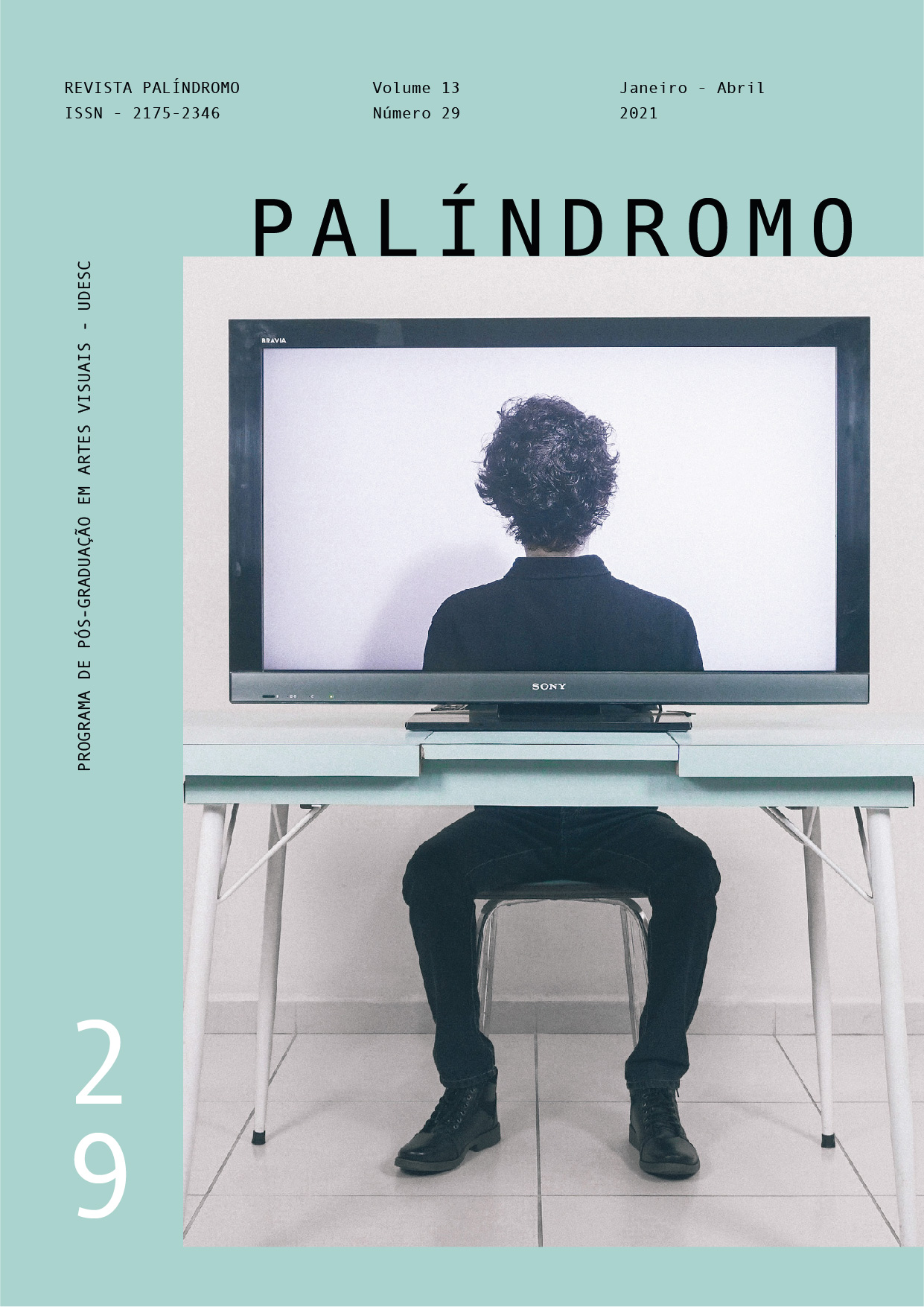Visual arts and remote education:
paroxism in interactions in pandemic times
DOI:
https://doi.org/10.5965/2175234613292021037Keywords:
Cyberculture, Visual Arts Teaching., Remote Teaching.Abstract
The article reflects on the Teaching of Visual Arts in a remote and pandemic context, from the incidence of instabilities, transformations and challenges in the teaching work, in which the school space is moved to the spaces of the homes of students and teachers. It is possible to observe the importance of bonds of trust in the family-school relationship, and of teachers as indispensable characters in this challenging context, where the arts together with educational practices suggest forms of [re] knowledge and social transformation in the midst of cyberculture.
Downloads
References
BALL, Stephen. Performatividades e Fabricações na Economia Educacional: rumo
a uma sociedade performativa. Educação & Realidade. V. 35, n. 2, 2010. Disponível
em: https://seer.ufrgs.br/educacaoerealidade/article/view/15865 Acesso em 24 out.
CONCEIÇÃO, Daiane L. da. Aplicativos educacionais no ensino da matemática: po-
tencialidades de uso em concepções e práticas docentes. 103 p. 2018. Dissertação
de Mestrado. Programa de Pós-Graduação em Educação. Universidade Federal de
Pelotas.
COUTINHO, Karine; ALVES, Jefferson. As Artes na Base Nacional Curricular. Textura,
v. 22, n. 50, p.241-264, abr/jun 2020. Disponível em: http://www.periodicos.ulbra.br/
index.php/txra/article/view/5538 Acesso em: 30 maio 2020.
CPERS. 562 alunos, 24 turmas, dois filhos, salário cortado; a realidade do educa-
dor gaúcho na pandemia. Disponível em: https://cpers.com.br/562-alunos-24-tur-mas-dois-filhos-salario-cortado-a-realidade-do-educador-gaucho-na-pandemia/ Acesso em: 20 out. 2020a.
CPERS. Em Assembleia histórica, quase 2 mil educadores firmam resistência pela
vida e contra aulas presenciais. Disponível em: https://cpers.com.br/em-assembleia-historica-quase-2-mil-educadores-firmam-resistencia-pela-vida-e-contra-aulas-presenciais/ Acesso em: 09 out. 2020b.
DELGADO, Paulette. La capacitación docente, el gran reto de la educación en lí-
nea. 2020. Disponível em: https://observatorio.tec.mx/edu-news/capacitacion-do-
cente-covid Acesso em: 27 out. 2020.
DIAZ, Esther. Las grietas del control – vida, vigilancia y caos. Buenos Aires: Editorial
Biblos, 2011.
EÇA, Teresa; MAÑERO, Julia; MAESO-BRONCANO, Ana. Reflexiones III · IV · V - Re-
flexiones desde la educación y las artes en la era COVID-19. Communiars. Revista de Imagen, Artes y Educacion Crítica y Social, v. 4, 2020. p. 14-20.
FILLIPI, Aminie. Estas son las ‘apps’ que han ayudado a los niños a hacer los debe-
res durante el confinamento. Disponível em: https://elpais.com/elpais/2020/06/04/ mamas_papas/1591248447_765322.html Acesso em: 19 out. 2020.
FOUCAULT, Michel. Vigiar e punir: nascimento da prisão. Petrópolis, Vozes, 1987.
HAN, Byung-Chul. Sociedade da transparência. Petrópolis: Vozes, 2017.
HAN, Byung-Chul. No enxame: perspectivas do digital. Petrópolis: Vozes, 2018.
HERNÁNDEZ, Fernando. Cultura Visual – Mudança Educativa e projeto de trabalho.
Porto Alegre: Artmed, 2000.
KOZINETS, Robert V. Netnografia: realizando pesquisa etnográfica online. Porto Ale-
gre: Penso, 2014.
MANSOURI, Fethi. As implicações socioculturais da COVID-19. In: UNESCO. Organi-
zação das Nações Unidas para Educação, Ciência e Cultura. Disponível em: https://
pt.unesco.org/news/implicacoes-socioculturais-da-covid-19 Acesso em: 09 out. 2020.
NÓVOA, António. Educação 2021: Para uma história do futuro. 2009. Disponível DOI: https://doi.org/10.35362/rie490679
em: https://repositorio.ul.pt/bitstream/10451/670/1/21232_1681-5653_181-199.pdf
Acesso em: 26 out. 2020.
NÓVOA, António; ALVIM, Yara. Nothing is new, but everything has changed: A
viewpoint on the future school. Prospects. V. 49, 2000. 35-41p. Disponível em:
https://doi.org/10.1007/s11125-020-09487-w Acesso em: 10 ago. 2020. DOI: https://doi.org/10.1007/s11125-020-09487-w
PRENSKY, Marc. Digital natives, digital immigrants. On the horizon, v. 9, n. 5, 2001. DOI: https://doi.org/10.1108/10748120110424816
Disponível em: https://www.marcprensky.com/writing/Prensky%20-%20Digital%20Natives,%20Digital%20Immigrants%20-%20Part1.pdf.Acesso em: 15 jul. 2020.
SANTOS, Isabel Cristina; ZAMPERETTI, Maristani Polidori. Tecnologias digitais e Artes
Visuais: o desenho virtual com o aplicativo Strava. In: João Batista Bottentuit Junior.
(org.). E-Book do I Simpósio Internacional de Tecnologias Digitais na Educação/
IV Simpósio Nacional de Tecnologias Digitais na Educação [recurso eletrônico]. 1ed.
São Luís - MA: EDUFMA, 2019, p. 1345-1358. Disponível em: https://drive.google.
com/file/d/12V0u_ykLns5A3xLUBYdJ4KqsOgAlNqq/view?usp=sharing Acesso em:
out. 2020.
SERRES, Michel. Polegarzinha: uma nova forma de viver em harmonia, de pensar as
instituições, de ser e de saber. Rio de Janeiro: Bertrand Brasil, 2013.
SOUZA, Fabiana L. de; ZAMPERETTI, Maristani Polidori. Práticas pedagógicas em Artes
Visuais com smartphone. Seminário de História das Artes, v. 01, p. 01-11, 2019. Dis-
ponível em: https://periodicos.ufpel.edu.br/ojs2/index.php/Arte/article/view/17910
Acesso em: 20 out. 2020.
UNESCO. Organização das Nações Unidas para Educação, Ciência e Cultura. Disponível em: https://pt.unesco.org/news/implicacoes-socioculturais-da-covid-19.Acesso em: 09 out. 2020.
UNICEF. Declaração Universal dos Direitos Humanos. Disponível em: https://www.
unicef.org/brazil/declaracao-universal-dos-direitos-humanos Acesso em: 23 out.2020.
VIANA, Gabriela. Oito motivos para não criar um perfil no Facebook para uma crian-
ça. 2013. Disponível em: https://www.techtudo.com.br/noticias/noticia/2013/09/
oito-motivos-para-nao-criar-um-facebook-para-uma-crianca.html Acesso em: 26
out. 2020.
WHITE, David; LE CORNU, Alison. Visitors and Residents: a new typology for online
engagement. First Monday, v. 16, n. 9, 2011. Disponível em: http://journals.uic.edu/
ojs/index.php/fm/article/view/3171/3049 Acesso em: 21 jan. 2020.
ZAMPERETTI, Maristani Polidori; ROSSI, Flávia Demke (2016). Tecnologias e ensino de
Artes Visuais – apontamentos iniciais da pesquisa. Holos (Natal. Online), v.8, p.190-
Disponível em: https://doi.org/10.15628/holos.2015.2031 Acesso em: 23 out. DOI: https://doi.org/10.15628/holos.2015.2031
Downloads
Published
Versions
- 2021-01-01 (2)
- 2021-01-01 (1)
How to Cite
Issue
Section
License
Copyright (c) 2020 Maristani Polidori Zamperetti

This work is licensed under a Creative Commons Attribution 4.0 International License.
COPYRIGHT STATEMENT
The articles published by the magazine are free to use, intended for academic and non-commercial applications. Copyright is all assigned to the magazine. The articles whose authors are identified represent the expression from the point of view of their authors and not the official position of Palíndromo Magazine. The author (s) commits to whenever they publish material referring to the article published in Palíndromo mention this publication as follows:
This article was originally published by Palíndromo magazine in its volume (place the volume), number (place the number) in the year of (place the year) and can be accessed at: http://www.revistas.udesc.br/index.php/palindromo


